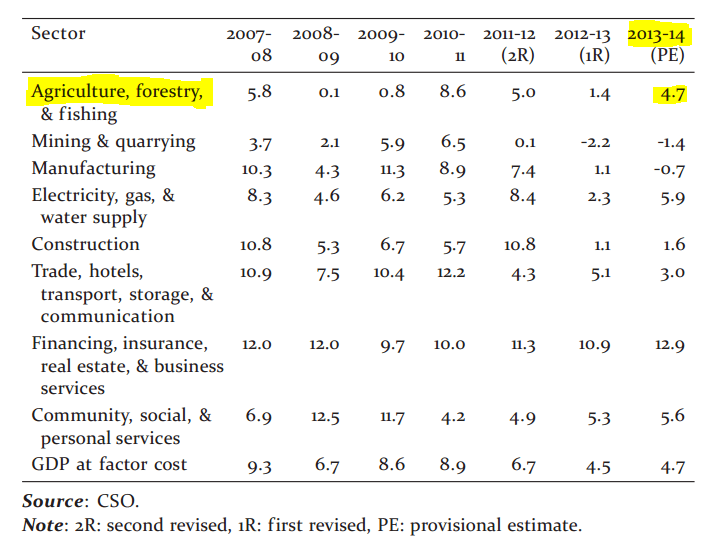These trivia about role of agriculture in Indian Economy is from Economic Survey 2013-14, so the data given below is latest from government sources and hence, relevant. We have compiled it for benefit of fellow aspirants. This will especially prove useful for civil services mains paper IV.
The share of agriculture in GDP has been constantly declining over the years. This was highlighted yet again in this years Economic Survey 2013-14, In eight years from 2000 to 2008 it has declined 6.4 percent.
Since agricultural market provides the backward linkage to Agro-based industries, it has to be viewed holistically as a seamless farm-to-fork value chain, comprising farming, wholesaling, warehousing, logistics, processing, and retailing including exports.
State of Agriculture in Economy
- About 60 per cent of the total foodgrains and oilseeds production occurs in the kharif season.
- Just about 35 per cent of arable area being irrigated, Indian agriculture is still largely dependent on rainfall.
- The south-west monsoon (from June to September) accounts for nearly 75 per cent of total annual rainfall in India.
- Horticulture production is estimated at 265 million tonnes in 2013 and for the first time has exceeded the production of foodgrains and oilseeds.
- An increase of 40 lakh ha in overall area coverage under foodgrains in 2013 as compared to previous year.And record foodgrains production of 264.4 million tonnes is estimated in 2013-14. This increase is due to : A) expansion in area, B) increase in MSPs of select foodcrops gave incentive to cultivation.

Role of agriculture in GDP growth at Factor Cost at Constant (2004-05) Prices
Concerns regarding Agriculture:
- Productivity levels in Indian agriculture are still much lower than the global standards. Productivity levels of rice and wheat have not risen significantly after the 1980s. Though cotton yields have taken tremendous leap over the last decade, due to Bt cotton.
- Soil degradation because of declining efficiency of fertilizer use.
- Alarming reduction in the water table, especially in states of Punjab and Haryana due to their inefficient cropping pattern.
- The nutrient based subsidy (NBS) policy, does not have “urea” under its purview which is used more than the others, so subsidy benefit is not reaching right beneficiary.
- The predominance of marginal and fragmented farms in India’s agriculture, with limited capital availability, hampers progress of farm mechanization.
- Domestic and international marketing of agricultural commodities needs immediate attention but past interventions of government
for building marketing set up have in fact created more barriers to trade. So, there is a need to reduce these market distortions.
Steps to be taken, as suggested by the Economic Survey document:
- Recommendation of the Task Force for Direct Transfer of Subsidy (headed by Nandan Nilekani) to shift to direct transfer of fertilizer subsidy to farmers in a phased manner needs to be considered.
- The Crop Diversification Scheme has been introduced in the Punjab and Haryana region to encourage farmers to choose crop alternatives and is also expected to promote technological innovations.
- There is need to facilitate a National Common Market for agricultural commodities with uniform taxes in the domestic market, and to foster a long-term stable trade policy for agricultural products.
- Need to expand the decentralized system of procurement for the PDS from present 11 states and UTs to all the states. This would help in- A) saving transport costs, B) reduce transit losses and other leakages, C) increase food availability, D) reduce food prices in the open market and E) ultimately rein in food subsidy.
Food Inflation:
In 2013-14 it has been a result of structural and seasonal factors with different items causing it at different times. Initially- cereals and proteins, then- vegetables esp. onions. Also, inflation increased for Protein- based items due to rising income levels and subsequent increase in consumption.
Three broad reasons for food inflation:
- Wastage of food in the supply chain due to inefficiencies in distribution channels of government.
- APMC Acts of state governments hamper creation of competitive conditions in distribution of commodities. No competition leads to ineffectiveness. This has prevented creation of a national market for agricultural commodities.
- Multiple layers of intermediaries in distribution of food articles have pushed up prices for consumers.
Solutions suggested in survey:
- Focus should be on reducing food wastage in the supply chain of distribution channels.
- Increased investment in marketing infrastructure, including modern warehouses, cold storages, reefer vans(refrigerated vans), scientific packaging and handling to strengthen distribution channels.
- State governments will have to remove restrictive provisions in the APMC Act and promote alternative trading options for farmers.
These snippets will be useful for Essay paper also. We will keep updating the data as new statistics release.





